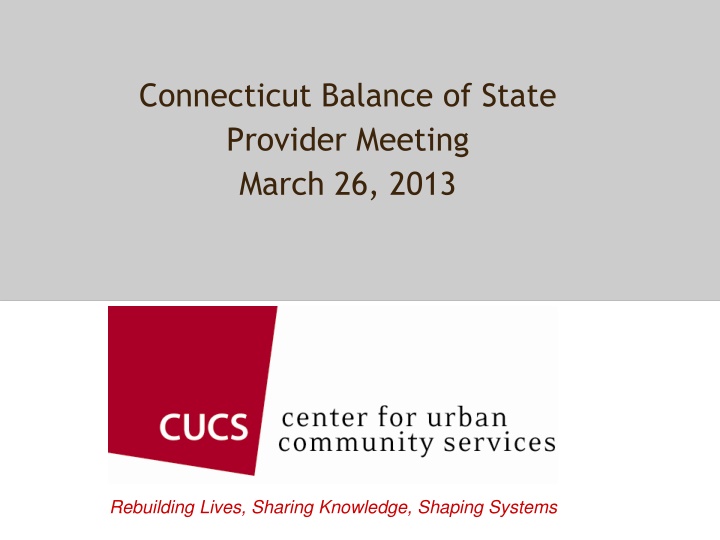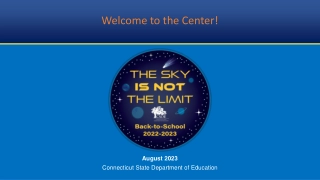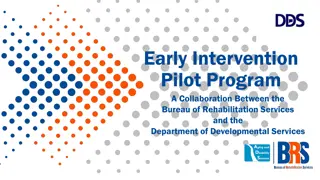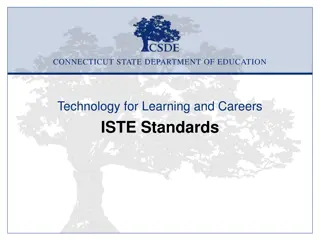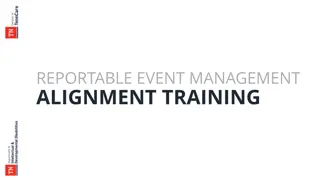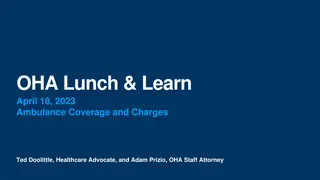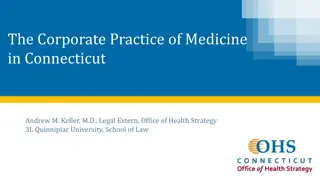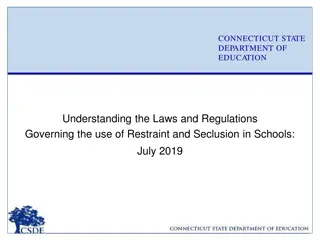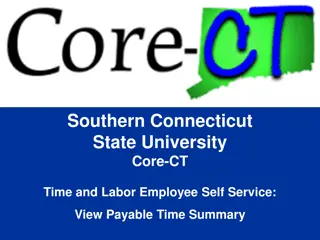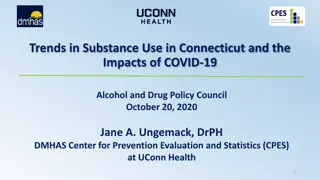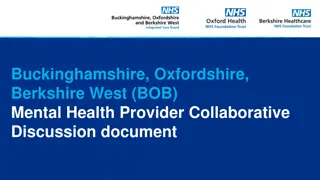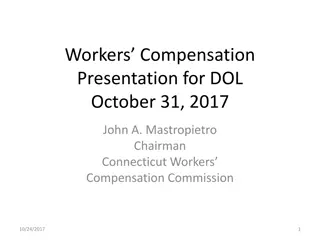Connecticut Balance of State Provider Meeting Overview
Connecticut Balance of State (BOS) Provider Meeting held on March 26, 2013 focused on rebuilding lives, sharing knowledge, and shaping systems. The meeting covered various topics such as BOS CoC regions, steering committee members, subcommittees, and priorities like HUD, HEARTH, and renewal evaluation criteria. The meeting aimed at enhancing collaboration and improving services for those in need across different localities in Connecticut.
Download Presentation

Please find below an Image/Link to download the presentation.
The content on the website is provided AS IS for your information and personal use only. It may not be sold, licensed, or shared on other websites without obtaining consent from the author.If you encounter any issues during the download, it is possible that the publisher has removed the file from their server.
You are allowed to download the files provided on this website for personal or commercial use, subject to the condition that they are used lawfully. All files are the property of their respective owners.
The content on the website is provided AS IS for your information and personal use only. It may not be sold, licensed, or shared on other websites without obtaining consent from the author.
E N D
Presentation Transcript
Connecticut Balance of State Provider Meeting March 26, 2013 Rebuilding Lives, Sharing Knowledge, Shaping Systems
Agenda Welcome, Introductions & Acknowledgments BOS Overview 2012 CoC Application Debrief HUD, HEARTH and BOS Priorities & Policies 2012 Renewal Evaluation Results 2013 Renewal Evaluation Criteria, Scoring & Process Annual Performance Review (APR) Highlights 2013 BOS NOFA Process
What is the BOS CoC? Balance of State regions: New Haven suburbs Hartford suburbs The Valley Windham/Tolland Counties Litchfield County Manchester SE CT - New London/Norwich Middletown/Middlesex Bristol Danbury New Britain
CT BOS Steering Committee JOHN MERZ, CO-CHAIR ACT STEVE DILELLA, CO-CHAIR CT DMHAS NEW BRITIAN ELLEN SIMPSON THE VALLEY MIDDLESEX/MIDDLETOWN HARTFORD SUBURBS RON KROM Localities with no representation NEW LONDON/NORWICH DAVE PASCUA NEW HAVEN SUBURBS CCEH MANCHESTER JILL BENSON FRAN MARTIN BRISTOL PHIL LYSIAK CONSUMER DAVID RINALDI DANBURY MILENA SANGUT DMHAS BARBARA GELLER DSS LITCHFIELD NANCY CANNAVO CASSANDRA NORFLEET-JOHNSON CHFA WINDHAM/TOLLAND KATHY CREES TERRY NASH CSH VA SARAH GALLAGHER PRESTON MAYNARD DOE LOUIS TALLARITA
BOS Steering Committee Members SC Members: CT DMHAS, DSS, DOE; CHFA, VA, CCEH, CSH, Consumer Local Sub-CoC Representatives Bristol, Danbury, Litchfield Cty, Manchester, Middlesex Cty, SE CT, Windham/Tolland Adding Criminal Justice, others per Action Plan Requirements for Local Sub-CoC Steering Committee representation: Locality must have: Functioning CoC or planning body At least 4 mtgs per year (and provide documentation of mtgs)
BOS Subcommittees Meet as part of Steering Committee Meetings (monthly or bi-monthly) HMIS - comprised of SC members and/or reps from localities with SC representation Review HMIS implementation and compliance with HUD Review HMIS Reports and Monitor Data Quality Ensure CoC is prepared for HEARTH by obtaining baseline performance data Identify HMIS support and training needs Report and make recommendations to BOS Steering Committee
BOS Subcommittees (cont) Mainstream Resources Monitor BOS program s performance on Accessing Mainstream Resources and Benefits Work on Discharge Planning with Foster Care, DOC, Hospitals Help coordinate BOS CoC Resources with other Mainstream Funding/Services NSP, VASH, DOE Coordinate trainings on entitlements and employment
2012 Application Debrief BOS Renewal Awards: $11,614,987 all 71 renewals funded Rental Assistance 29 projects - $5,766,934 Leasing 30 projects - $4,332,786 Operating/Services 11 projects - $1,457,202 HMIS 1 project - $58,065 Reallocation and New Project awards to be announced this Spring
2012 Debrief NOFA: No more Exhibit 1 and 2 Additional Planning Questions and Outcome Measures Ranking and Tiering 2013 NOFA due out May/June!!!!!!!!!
2012 CoC Scoring Factor Performance Strategic Planning - See CoC Action Plan CoC Housing & Services Leveraging 2011 Points 32 2012 Points 34 22 55 14 14 6 In performance (3) HMIS 13 PIT - 8 Not in scoring Homeless Needs & Data Collection 26 6 Housing Emphasis Bonus admin at or below 7% and 100% CH in bonus Total Possible N/A 4 100 134
New Budget Categories Supportive Services Beginning with 2012 9. Legal Services 1. Assessment of Service Needs 10. Life Skills 2. Assistance with Moving Costs 11. Mental Health Services 12. Outpatient Health Services 3. Case Management 13. Outreach Services 4. Child Care 14. Substance Abuse Treatment Services 5. Education Services 6. Employment Assistance 15. Transportation 7. Food 16. Utility Deposits 8. Housing Counseling Services
New Budget Categories - Operating Funds Beginning with 2012 Application 1. Maintenance/Repair Exterminating, garbage removal, janitorial contracts, annual 2. Property Taxes and Insurance 3. Replacement Reserve 4. Building Security 5. Electricity, Gas, and Water 6. Furniture 7. Equipment (lease, buy)
2012 Debrief 2012 Housing Inventory (HIC) Emergency Shelter: beds Individual beds: 497 Families: 124 units/385 beds Transitional Housing: 541 beds Individual beds: 255 Families: 83 units/232 beds Permanent Supportive Housing: units Individuals: 1076 Families: 274 units/813 beds
2012 Debrief 2012 PIT Homeless Count Single Adults - People Sheltered: 555 Transitional: 217 Chronic:170 Total: 772 Families - Households Sheltered: 106 Transitional: 70 Chronic: 13 Total: 176
2012 Consolidated Application (formerly Exhibit I) Performance and 2013 Goals In 2012, CoC met objectives in identified in 2011 CH Beds CH Beds in 2012 - 623 2013 Goal is 652 TH to PH 78% of people exiting TH went to PH in 2012 2013 Goal is 79%
2012 Consolidated Application (formerly Exhibit I) Performance and 2013 Goals 2 PSH Retention 90% of people stayed in PSH six months or longer 2013 Goal is 90% Decrease # of Homeless Families There were 187 homeless families in 2012 2013 Goal is 186 Employment 22% of people were employed at program exit in 2012 2013 Goal is 23%
2012 Consolidated Application (formerly Exhibit I) Performance and 2013 Goals - 3 NEW -- Obtained mainstream benefits at program exit Standard is 20% In 2012, 72% had mainstream benefit at exit 2013 Goal is 73% NEW Reallocation 2013 Goal is to reallocate 1 TH or SSO project Please contact CoC asap if you are interested in reallocation
Mainstream Resources at Exit BOS Performance Income Sources at Exit SSI? SSDI? Social? Security? General? PA? TANF? Children's? Health? Ins? Veterans? Benefits? Employment? Income? Unemployment? ? Veterans? Health? Care? Medicaid? Food? Stamps? Other? (please? specify)? No? Financial? Resources? 2010? n=294? N 51? 33? 8? 22? 27? 17? 3? 80? 15? 4? 59? 149? 2011? N=309? ? 2012? N=317? N % 48? 16? 40? 13? 15? 5? 31? 10? 36? 12? 15? 5? 2? 1? 80? 26? 19? 6? 2? 1? 58? 19? 166? 54? % 17? 11? 3? 7? 9? 6? 1? 27? 5? 1? 20? 51? N 50? 37? 8? 23? 46? 11? 13? 70? 25? 13? 148? 217? ? 21? ? ? 57? % 16? 12? 3? 7? 15? 3? 4? 22? 8? 4? 47? 68? ? 7? ? 18? 23? 8? 26? 8? 44? 15? 42? 14? ?
HEARTH Highlights HEARTH INDICATORS Decrease numbers of people who are homeless Reduce returns to homelessness Decrease length of stay in the homeless system Increase income, exits to PH
HEARTH Highlights - Rental Assistance & Leasing No more SHP and S+C programs are together under HEARTH as one Rental Assistance Projects Old S+C and projects that converted Tenant holds lease, rental assistance is administered through housing authority or DMHAS Leasing Projects Agency holds lease, HUD is exploring different options and will issue guidance on this Services/Operating Projects Projects with services and/or operating monies
HEARTH Highlights - Performance Greater emphasis on performance Report in project application and APRs: Obtain/maintain PH Maintain/increase income Focus on: APRs submitted on time Regular draw-down of funds Spending all program funds Match and Leveraging with letters/documentation
HUD Policies Reminders CoC Required Educational Assurances CoC required to demonstrate that it is: Collaborating with local education agencies to assist in identification of homeless families and Informing homeless families and youth of their eligibility for McKinney-Vento education services CoC required to demonstrate that it is: Considering education needs of children when families are placed in emergency or transitional shelter and Placing families with children as close as possible to schools of origin
Programs Required Educational Assurances Projects and programs serving families with children must demonstrate that their programs are: Establishing policies and practices that are consistent with the education subtitle of McKinney-Vento Act and other laws relating to education and related services to homeless people Designating a staff person to ensure that children are enrolled in school and connected to services in the community including programs such as: Head Start Part C of the Individuals with Disabilities Education Act McKinney-Vento education services
Rights under the Education Subtitle of McKinney Vento Liaisons in every school district with responsibilities to identify homeless children, assist with enrollment and participation, refer families to Head Start and other services School Stability schools must keep in original schools, unless not in best interest or not desired by parent/youth Transportation schools must provide for stability and access, even crossing district lines Immediate Enrollment even without records
Rights under the Education Subtitle (cont) Dispute process families and youth can dispute school decisions; must be enrolled during the dispute process Homeless children and youth are categorically eligible for free school meals; they do not have to fill out paperwork (list from liaison or shelter director suffices) Homeless children and youth are categorically eligible for extra support through Title I (Education for Disadvantaged Federal program), no matter what school they attend
Rights under the Education Subtitle - Special Populations Unaccompanied youth: a child or youth who meets the definition of homeless and is not in the physical custody of a parent or guardian. These youth are typically fleeing abuse or neglect at home, but are not involved in the child welfare system Liaisons must consider their wishes in school placement, help with disputes Preschool children: 51% of all children in HUD- funded shelters are under the age of 6. Liaisons must ensure homeless children have access to Head Start and LEA-administered preschool programs
HUD Policies Reminders Requirements for Mainstream Resources Enrollment Case managers systematically assist clients in completing applications for mainstream benefits Homeless assistance providers supply transportation assistance to clients to attend mainstream benefit appointments, employment training, or jobs Homeless assistance providers use a single application form for four or more mainstream programs Homeless assistance providers have staff systematically follow-up to ensure mainstream benefits are received
Addressing Street, Veteran and Youth Homelessness Describe the CoC's current efforts to combat homelessness among veterans and youth Identify organizations that are currently serving these populations, how these efforts are consistent with CoC strategic plan goals, and how the CoC plans to address this issue in the future Describe the CoCs efforts to identify and engage persons that routinely sleep on the streets or other places not meant for human habitation
Coordinated Access Required by HUD Opening Doors - Crisis Response Group working on plans Next meeting 4/19 @ 1:00 pm Build and expand existing systems ex. 211 Implementation to begin this summer
BOS Admissions Policies - Marketing Marketing for Housing and Services: NOFA Language: Describe the procedures used by the CoC and its programs to market housing and supportive services to eligible persons regardless of race, color, national origin, religion, sex, age, familial status, or disability who are least likely to request housing or services in the absence of special outreach Providers should have non-discrimination policies in place and assertively outreach to people not involved in the homeless system. BOS Policy to be adopted May 13
BOS Admission Policies Discharge Planning Accepting People from Other Public Systems of Care: The HEARTH Act stipulates that state and local governments have policies in place to ensure that public institutions do not routinely discharge individuals into homelessness. Before accepting participants into CoC programs from the Mental Health, Foster Care, Correctional or Public Health Systems, providers will work to ensure that all other discharge options have been exhausted. Accepting a person directly from publicly-funded institutions should only be considered if there are no other viable housing options and the person meets the eligibility criteria for the bed or unit.
BOS Admission Policies Families with Children <18 Keeping Families Intact Publicly funded Shelters and Transitional Housing in the BOS CoC cannot deny admission or separate families with children under 18 based on the age or gender of a child unless they have obtained a waiver from the BOS CoC Steering Committee. Enrollment in School BOS Providers will make every effort to ensure that homeless children are enrolled in school within 48 hours of entry into the program.
HMIS Update and Discussion New Vendor Empowered Solutions Group Universal Data Elements Goal is to have 0% no value and low refused/unknown Bed Coverage Goal is to have 86% for ES, TH, PSH and RR Training Available www.cthmis.com/site/
Performance HMIS Universal Data Elements Universal? Data? Element? Social? Security? #? Date? of? Birth? Ethnicity? Race? Gender? Vet? status? Disabling? Condition? Residence? prior? to? program? entry? Zip? Name? Housing? status? Destination? Head? of? household? no? values? (%)? 2? 3? 3? 3? 2? 6? 7? 5? refused? or? unknown? (%)? 7? 1? 1? 3? 0? 2? 1? 1? 5? 0? 9? 0? 0? 2? 0? 1? 26? 0? ?
2012 Renewal Evaluation Criteria Criteria for Evaluating CoC Renewal Projects Occupancy at 90% 85% of people in PSH stay 7 at least 6 months 80% leaving TH go to permanent housing 30% of leavers have some form of health insurance 50% of leavers have food stamps 25% of leavers have income from employment
2012 Renewal Evaluation Criteria (cont) Criteria for Evaluating CoC Renewal Projects 85% maintain or increase income at exit 90% did not leave for an undesirable destination (unknown, unsheltered, jail, etc) 90% leave with financial resources (cash and non-cash) 90% of HUD Required Data Elements are in HMIS 35% Consumer survey response rate Consumer satisfaction survey score
2012 Renewal Evaluation Results All Projects 2012 45 13 10 All Projects 2011 42 13 10 TH 2012 41 13 10 PSH 2012 46 14 10 TH 2011 38 13 9 PSH 2011 43 13 10 Criteria APR (50) Surveys (15) HMIS Standards (10) HMIS Data Quality (10) Budget Accuracy (15) Final Score (100) 10 9 10 10 9 9 n/a 92 14 88 n/a 87 n/a 93 14 84 14 89 96 100 61 91 100 54 87 97 79 97 100 61 84 97 76 93 100 59 Median High Low 76 76 9 65 9 65 # of Projects scored
2012 Renewal Scores and Corrective Action Policy Each year the Steering Committee establishes a minimum scoring threshold. Projects scoring below 75 must do a corrective action plan. Agencies in corrective action process are not eligible to apply for funding for new projects. Programs in corrective action status for 2 consecutive years may be at risk of losing their funding. (Has never happened)
Achieving HEARTH Performance Measures CT Performance Measures (see handout) Based on HUD/HEARTH benchmarks Incorporated in CT BOS CoC standards for renewal projects
2013 BOS Renewal Evaluation Criteria Criteria for Evaluating CoC Renewal Projects Occupancy at 90% 90% of people in PSH stay 7 at least 6 months 85% leaving TH go to permanent housing 60% of leavers have some form of health insurance 60% of leavers have food stamps 25% of leavers from PSH have income from work 40% of leavers from TH have income from work 85% maintain or increase income at exit
2013 BOS Renewal Evaluation Criteria (cont) Criteria for Evaluating CoC Renewal Projects 10% or less leave for did not leave for shelter, street or unknown 80% leave with non-cash financial resources 35% Consumer survey response rate Consumer satisfaction results Timely draw-down of funds Spending all grant funds awarded for last full year of operation HUD monitoring results and findings 90% of HUD Required Data Elements are in HMIS Meet HMIS compliance standards
HUD APR Why is it important? The APR impacts your program in important ways: Used by HUD to: Evaluate your progress Aggregate national data about homeless people & programs Review HEARTH Indicators: Decrease numbers of people who are homeless Reduce returns to homelessness Decrease length of stay in the homeless system Increase income, exits to PH
HUD APR Why is it important? - 2 The APR impacts your program in important ways: Used by CT BOS to: Score and rank programs for renewal Compile aggregate data for the HUD application, which affects how much $ the CT BOS CoC receives Necessary to keep CoC and project funds flowing
HUD Standards Measured through the APR: At least 80% of homeless persons stay in permanent housing for more than 6 months At least 65% of homeless persons in Transitional Housing move into permanent housing At least 20% of homeless persons are employed at exit At least 20% of leavers have noncash benefits at exit
Other HUD Standards Set by Programs Objective related to housing stability: # of Persons age 18 and older who maintained or PSH or exited to PH as of the end of the operating year or program exit Objective related to improving income: # of Persons age 18 and older who maintained or increased their total income (from all sources) as of the end of the operating year or program exit
APR Key Definitions - Leavers and Stayers Leavers: Persons who exited the program and are no longer enrolled in the program as of the last day of the reporting period. Stayers: Persons who were in the program on the last day of the reporting period. This includes clients who exited the program and re-entered the program before the end of the reporting period.
APR Key Definitions Client Type Adult: Any person 18 years of age or older. A person s age is based on the program entry date closest to the end of the operating year. If a person entered the program prior to the start of the reporting period, the person s age should be based on the first day of the reporting period.
APR Key Definitions Client Type Children: Any persons under the age of 18. A person s age is based on the program entry date closest to the end of the operating year. If a person entered the program prior to the start of the reporting period, the person s age should be based on the first day of the reporting period.
APR Key Definitions - Households Household without Children: A household that does not include any children, including unaccompanied adults, multiple adult households, and pregnant women age 18 or older not accompanied by other children. For the purposes of APR reporting, households without children that contain multiple persons should be counted as one household without children.
APR Key Definitions - Households Household with Children Any household with at least one child. There are two types of households with children: Households with at least one adult and one child include households composed of at least two persons, one of whom is an adult and one is a child. Households with only children are composed only of persons age 17 or under, including unaccompanied children, adolescent parents and their children, adolescent siblings, pregnant women under 18 years old, or other household configurations composed only of children
